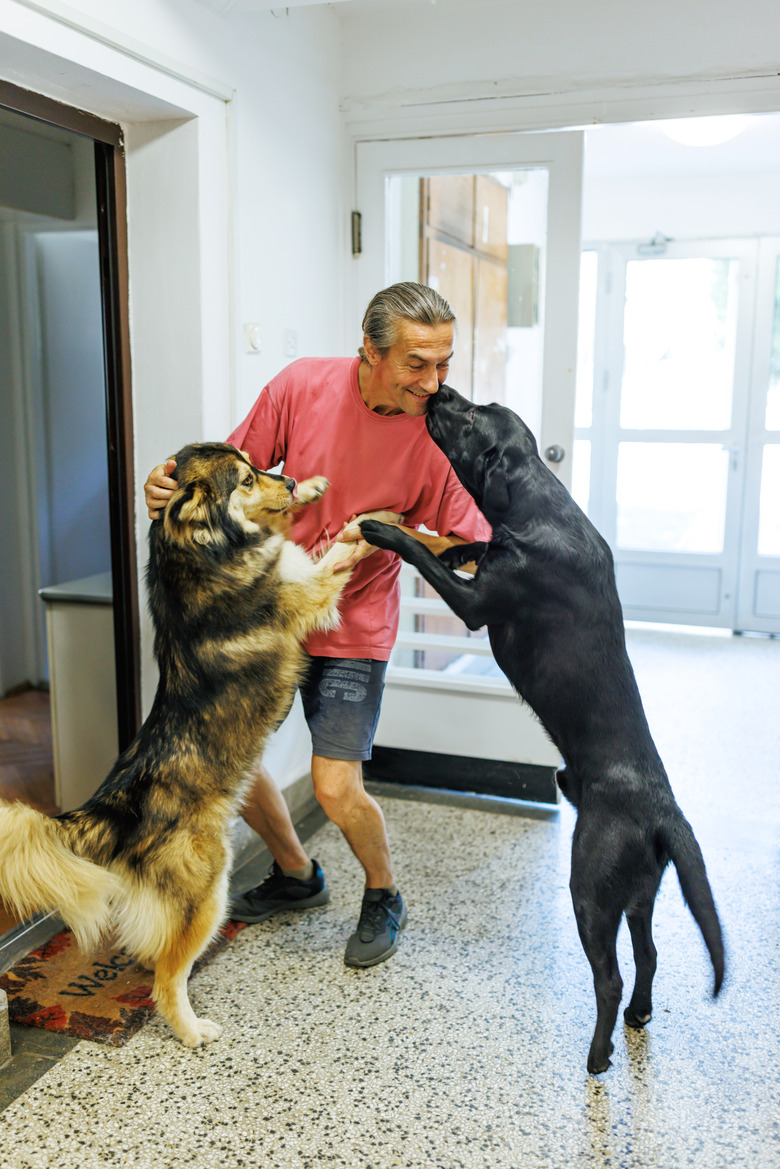Can A Dog Cry? Turns Out They Do Miss You
We've all seen tear stains on some dogs, and often, they're caused by allergens, a blocked tear duct, or simply because of the dog's facial shape. Sometimes, however, dogs may appear to tear up when they become emotional, like when they get excited or sad, but are they actually crying? Is it possible for dogs to cry tears of sadness or joy, just like we do?
In a new study published in Current Biology, a team of researchers in Japan set out to see if emotions can make dogs produce tears. What they found (hold on to your heartstrings) was that dogs' eyes can and do tear up when they see their people, and that oxytocin, AKA the love hormone, stimulates tearing up. Before you get too weepy, it's important to note that tear production and crying aren't necessarily the same thing, especially when we look at why certain animals produce tears, and the purpose those tears serve.
Reuniting with owners and the tears that follow
Reuniting with owners and the tears that follow
To start, the team conducted experiments with dogs and their human owners in their own homes. The owners left their dogs for 5 to 7 hours before returning, and the team then used the Schirmer tear test to measure the volume of dog tears produced by the canines after reuniting with their owners. Another identical experiment was conducted at a dog daycare center, and the tear volumes were measured when the dog's owner came to pick them up versus when a familiar non-owner, like a housemate or dog walker, came to pick them up.
What they found in both cases was that dogs teared up more when they reunited with their owners than with anyone else. In addition to that, they also discovered that the presence of oxytocin significantly increased the volume of tears the dogs produced. Oxytocin is a hormone that's often dubbed "the love drug," and our bodies produce it naturally during sex, cuddling, and when we fall in love with someone. It's also what helps mothers and babies bond, as well as pets and their owners. This tear-filled discovery suggests that positive emotions may play a role in tear production in dogs.
Can a dog cry tears of joy?
Can a dog cry tears of joy?
Dogs don't cry tears of joy in the way that we do (at least, not that we can prove), but they can produce tears with the help of joyful chemicals. According to this study, tear production significantly increased when an oxytocin solution was applied to a dog's eyes, versus when a peptide solution was applied. The love hormone did technically result in more tears produced, and studies in mice have shown that oxytocin can stimulate tears in the lacrimal gland just above the eye.
Regardless of why dogs tear up, people seem to love it. On the human side of this experiment, the scientists found that people felt more connected to dogs who looked like they were crying over dogs who didn't. The people in this study were shown photos of dogs who had synthetic tears in their eyes and dogs with no tears, and more positive scores were given to the teary-eyed dogs. This might explain why some pet parents consider their dogs their "fur babies," and the study suggests that the nurturing response people have when they see a dog who looks sad may deepen this mutual interspecies relationship.
What is the Schirmer tear test?
What is the Schirmer tear test?
To conduct these experiments, the researchers used a process called the Schirmer tear test. This test is also conducted on people to determine whether an eye is producing enough tears to keep it properly moist. To use it, an eye doctor places strips of filter paper on the lower part of the eye, and then the part of the strip that was moistened by tears is measured for the result.
Are humans the only animal that cries?
Are humans the only animal that cries?
If you're defining crying as producing emotional tears due to sadness or pain, then yes, according to research conducted so far, we are the only ones who do this. Other animals, like dogs, use behavioral changes and body language to express what we assume to be pain, sadness, and even grief, including decreased appetite, increased sleeping, and social withdrawal. This study is the first report of its kind to show how positive emotion affects tear secretion, so hopefully, we'll have more insight into whether our dogs feel things when they tear up in the near future.
Humans are certainly not the only animals to produce tears, however, as their main function is to keep the eyes lubricated and healthy. In addition to that, tears can work as chemosignals and may contain certain hormones and pheromones, depending on the animal. For example, mouse tears contain sex pheromones, and because dogs commonly lick around the eyes and noses of other dogs, their tears may serve as social cues that don't necessarily have emotions attached to them.
Can a dog cry?
Can a dog cry?
Dogs can and do cry, but unlike us, their form of crying doesn't necessarily involve spilling tears. Dogs usually cry through vocalizing, which can sound like whimpering, barking, or even howling. Common reasons for dogs to vocalize when they're stressed include isolation distress, separation anxiety, and physical pain.
Can a dog cry tears?
Can a dog cry tears?
Dogs can certainly produce tears, and according to this study, the more oxytocin they experience, the more tears they produce. Whether they cry happy tears or sad tears for emotional reasons is undetermined. Dogs don't usually tend to produce tears when they display other signs of distress, like whining or howling. If your dog has excessive tearing, it's likely due to an allergy or an eye ailment and not because they are sad or crying, and they should be seen by your veterinarian.
Do dogs cry from sadness?
Do dogs cry from sadness?
As far as research goes, there's no proof that dogs cry from sadness; at least, they don't cry tears when they're sad. When dogs are distressed, however, they will sometimes engage in dog behaviors like vocalization or isolation to express themselves.
Why your dog cries during crate training?
Why your dog cries during crate training?
If your dog frequently whines or cries out while they're crate training, it's likely because they are trying to get your attention. Puppies cry out to alert their mothers that they need care in some form, and this behavior can carry out well into adulthood and apply to the non-canine family members around them. Your dog may also need to be let out to use the bathroom.
Why do dogs cry at night?
Why do dogs cry at night?
Dogs who live outside may whine, bark, or vocally cry as a warning, or to establish territorial boundaries. Some indoor dogs might whine or cry at night as a way to burn off some steam, similar to how dogs get the zoomies, which is technically known as FRAP, or frenetic random activity periods. Young dogs and puppies usually do this at night because they're just bored or wired from napping all day. If you notice frequent or onset crying from your dog, it's recommended that you check in with your veterinarian in case your dog is in physical pain.
The bottom line
The bottom line
Dogs have been shown to produce more tears when they're reunited with their pet parents than when they're reunited with a familiar non-owner. The dogs in this study also produced more tears when they were exposed to an oxytocin solution than when they were exposed to a peptide solution. The human participants of the study were shown photos of dogs with tears in their eyes, and photos of dry-eyed dogs, and more people responded positively to dogs who appeared to be teared up than to the dogs who didn't.




